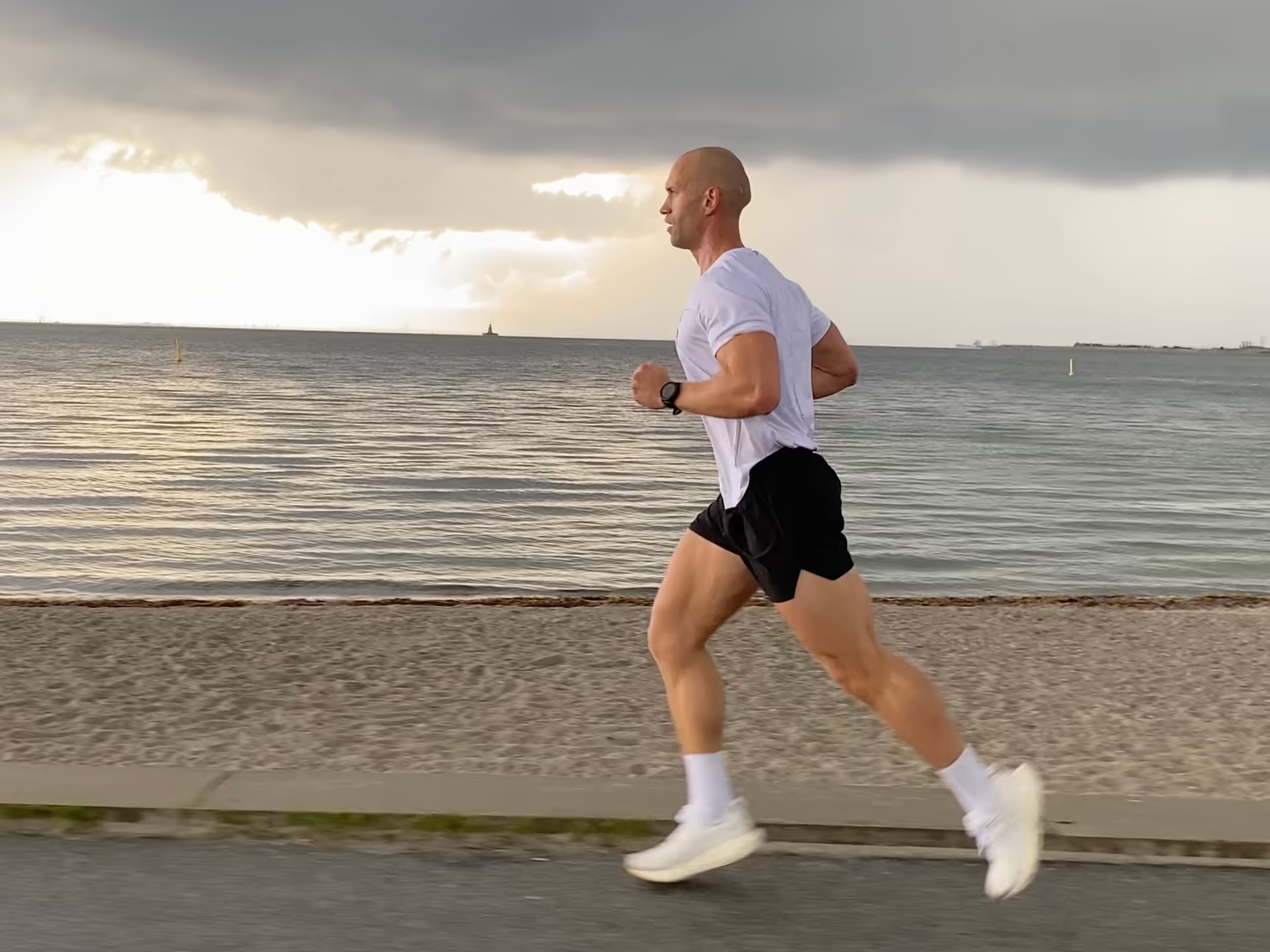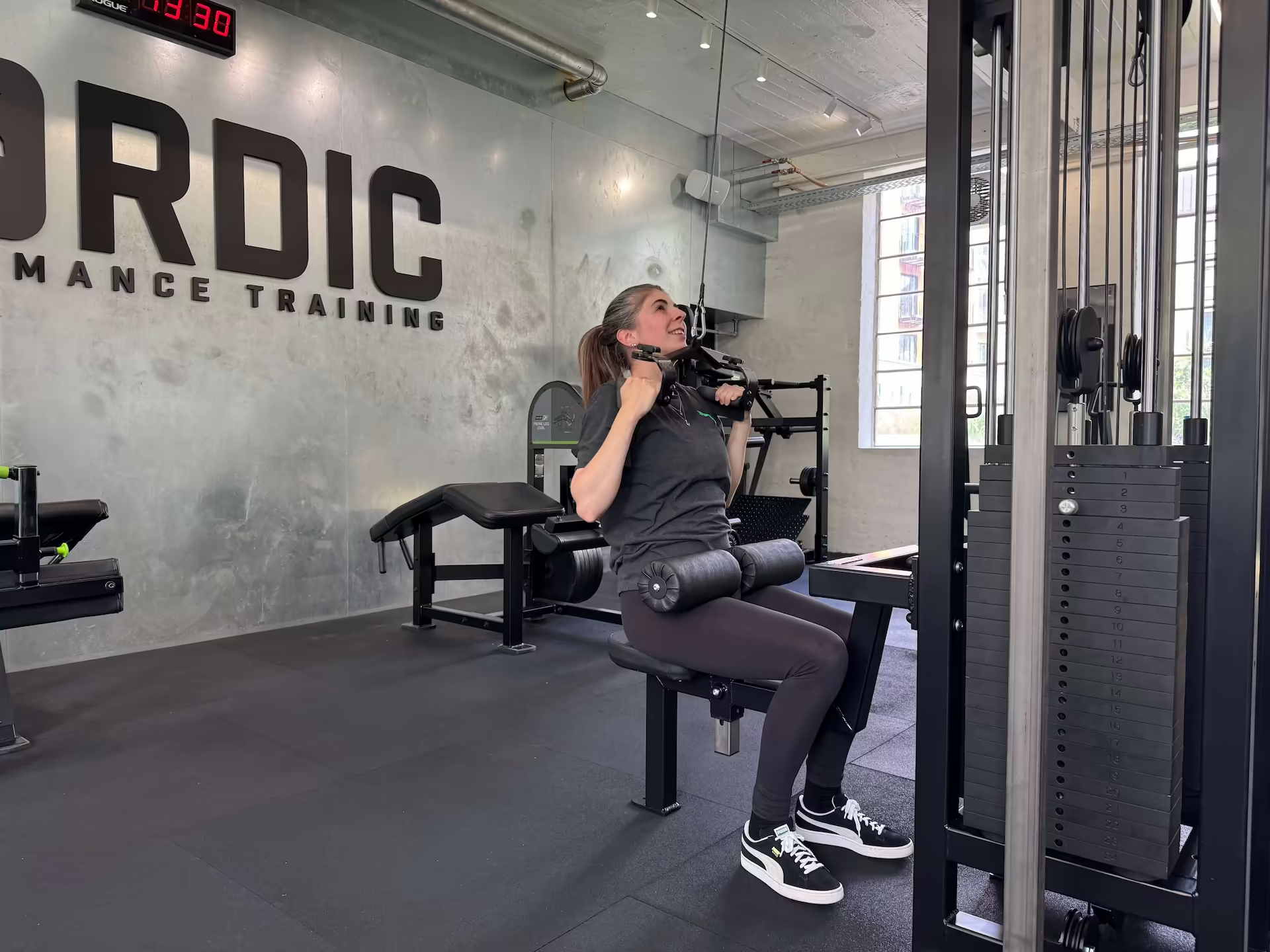Simple and Effective DHL Running Program – Ready for the Relay Without Stress
Many believe you need to train like an elite runner to handle the DHL Relay. But after over 10 years of coaching Copenhagen office workers for their first relay race, we know that's simply not necessary.
We help many clients annually with either completing their first DHL or improving their time, and not a single client got injured along the way. Not because they trained less – but because they trained smarter and more structured.
Three months ago, Laura came to us. She's 34 years old, works as a marketing manager in Nørrebro, and had signed up for the DHL Relay with four colleagues. The problem? She hadn't run since high school.
"I'm afraid of disappointing the team," she said honestly. "All the others seem so fit."
Today Laura runs 5 km in 30 minutes and looks forward to the relay race. She followed our simple approach and trained three times a week for 12 weeks. Same principles as in our complete 5 km guide.
What is the DHL Relay? – Copenhagen's Most Social Race
The DHL Relay is not an individual race. It's a team race where five people each run 5 km through Copenhagen's streets on a sunny day in May.
The atmosphere is unique. Unlike traditional races, it's not about personal records or placement. It's about team spirit, fun, and the shared experience of accomplishing something together.
Approximately 100,000 runners participate annually, divided among around 20,000 teams. This makes it Northern Europe's largest relay race – and simultaneously the most inclusive.
What makes the DHL Relay special: For many of our clients, DHL becomes their first real running experience. Maria, who works as an accountant in Frederiksberg, described it like this: "I would have given up halfway if I had been running alone. But when I knew my colleagues were waiting for me at the relay baton, there was no possibility of stopping."
How Long Does It Take to Train for DHL? – 12 Weeks is the Standard
The question we get most often: "How quickly can I be ready for DHL?"
As a general rule, we recommend 12 weeks for beginners. Not because it can't be done faster – but because 12 weeks gives the body time to adapt without injuries.
Our experience with DHL preparation:
- 6-8 weeks: Possible for people with good basic fitness
- 12 weeks: Optimal for most beginners and slightly experienced
- 16 weeks: If you want to be completely sure or have previous injury problems
Before You Start – DHL-Specific Preparations
Equipment – The Most Important for DHL
You don't need much for DHL, but the right equipment makes the difference.
Running shoes: Start with comfort above all else. A max-cushioned running shoe provides the best start for beginners.
Clothing: DHL is typically run in August weather – anything from 12 to 25 degrees. Choose breathable materials and avoid cotton.
For detailed product recommendations and buying guides, see our complete 5 km guide.
Warm-up Specific to DHL
DHL day can be chaotic. Therefore, a simple warm-up routine is worth its weight in gold:
5-minute DHL warm-up:
- 2-3 minutes brisk walking
- 10 × leg swings forward/backward per leg
- 10 × knee lifts in place
- 15 × bodyweight squats
This can be done in the limited space you have in the starting area.
DHL-Specific Training Program: 0 to 5 km (12 weeks)
This program is designed specifically for DHL's requirements – to complete 5 km injury-free and with energy left to enjoy the day.
Week 1-4: Adaptation
- Session 1: 6×200m running (Z3-Z4), 2 min walking break
- Session 2: 20 min continuous walking at moderate pace (Z2)
- Session 3: 6×200m running (Z3-Z4), 2 min walking break
Week 5-8: Capacity Building
- Session 1: 6×400m running (Z3-Z4), 90 sec walking break
- Session 2: 2–3 km mixed walking/running (Z2-Z3)
- Session 3: 8×200m running (Z4), 90 sec walking break
Week 9-10: DHL Preparation
- Session 1: 4×800m running (Z4), 2 min walking break
- Session 2: 3–4 km mixed walking/running (Z2-Z3) – goal: mostly running
- Session 3: 6×400m running (Z4), 90 sec walking break
Week 11: Dress Rehearsal Week
- Monday: 3 km mixed walking/running (mostly running)
- Wednesday: 3×800m at comfortable pace, 2 min walking break
- Friday: Rest or 2 km easy walking
- Sunday: 4 km test run – run as much as you can
Week 12: DHL Week (tapering)
- Monday: 2 km easy walking/running + 3×200m strides
- Wednesday: 4×400m at comfortable pace, 90 sec break
- Friday: Rest or 15 min easy walking
- DHL day: You're ready!
For more advanced programs (35→25 min or 25→20 min), see our complete 5 km guide.
The DHL Route in Copenhagen – What You Need to Know

Route Characteristics
The DHL route changes each year, but certain things remain constant:
- Many 90-degree turns
- Mix of asphalt and gravel paths
- Moderately hilly terrain
- Potential bottlenecks at narrow passages
Expect 10-20 seconds extra per kilometer due to turns and other runners compared to your training runs.
Train on Similar Conditions
To prepare for DHL conditions:
Gravel paths and turns:
- Frederiksberg Have: Perfect mix of gravel paths and turns
- Fælledparken: Large, open areas with varying surfaces
- Søndermarken: Natural gravel paths
Asphalt with direction changes:
- Around the Lakes: Many direction changes
- Harbor Promenade: For tempo runs
How to Avoid Injuries Before DHL
The 200+ DHL participants we've followed without injuries followed these rules:
The 4 Most Important Principles
- Gradual progression: Never more than 10% weekly increase
- Focus on completion before tempo: Distance first, speed comes later
- Respect rest days: Minimum two rest days between running days
- Listen to warning signals: Persistent soreness = take an extra day
Load Management is Everything
The most well-documented factor in injury prevention is load management – how quickly you increase training volume. This is more important than running style, shoes, or stretching.
Race Day – Your DHL Checklist

The Week Before DHL
- Monday-Wednesday: Light sessions, keep the body moving
- Thursday: Rest day or 20-30 min walking
- Friday: 15 min easy run + 3×100m strides
- Saturday: Rest or easy walking
DHL Morning
Eat as normal: 2-3 hours before: light carbohydrates (oatmeal, banana, rye bread)
Pack essentials:
- Same shoes and clothing as on your best training days
- Safety pins for race number
- Change of clothes for afterward
Warm-up on the day: Use your 5-minute routine from training
Maintain Continuity – Motivation That Works
The Social Element
DHL's greatest strength is the team. Use it in training:
- Find a training partner from the team
- Share your progress on social media
- Plan individual joint training sessions
Practical Solutions
Training rhythm: Find a time that suits the whole group – many DHL teams train together on Tuesdays or Thursdays after work.
Backup plan: Always have an indoor option (treadmill or stairs) for bad weather.
Strength Training – The Missing Link to DHL Success
One of the most overlooked factors in DHL preparation is strength training. Research shows that runners who strength train experience 50% fewer injuries.
Concrete benefits for DHL:
- Fewer injuries during preparation
- Better posture when you get tired
- More energy on the actual day
- Faster recovery after the relay
We recommend 1-2 weekly full body sessions as a supplement. It takes 45-60 minutes and can make the difference between a good and fantastic DHL experience.
For concrete strength training programs that complement your DHL preparation, read our guide: ["Full Body Program (1–3 Days/Week): Why Less Really Is More [2025 Guide]"]
Frequently Asked Questions
How long does it take to run 5 km as a beginner for DHL? 35-45 minutes is completely normal. The most important thing about DHL is the team and completion – not the time.
Can you train up in 8 weeks? If you have good basic fitness, yes. For real beginners, we recommend 12 weeks.
Is it important to train on gravel paths? It helps, but regularity is more important than perfect terrain matching.
What if I can't follow the program precisely? Adapt it to your everyday life. Better 2 times a week consistently than 3 times sporadically.
Conclusion – Your Path to DHL Success
The DHL Relay is about community, not about being fastest. It's the team's day – not individual performance.
The clients who get the most joy from DHL:
- Start realistically and train gradually
- Focus on injury-free completion
- Remember it's a social event
- Enjoy the process as much as the day
Your DHL experience doesn't begin on race day. It begins the first time you decide to take the first step together with your team.
For deeper training principles, detailed programs, and comprehensive advice, read our complete guide to 5 km running.
Good luck with the preparation – see you at the finish line!
References
Sports Analysis Institute (2020): Danes' Exercise and Sports Habits
DHL Relay/Sparta (2024): Official participant statistics
Daniels, J. (2014). Daniels' Running Formula (3rd ed.). Human Kinetics. One of the most recognized systems in running training. Used by both recreational and elite athletes. Explains training zones, strides, and weekly structure.
Seiler, S. (2010). What is best practice for training intensity and duration distribution in endurance athletes? International Journal of Sports Physiology and Performance, 5(3), 276–291. Foundation for 80/20 training and polarized intensity distribution. https://doi.org/10.1123/ijspp.5.3.276
Fitzgerald, M. (2014). 80/20 Running: Run Stronger and Race Faster by Training Slower. Penguin Random House. Practical approach to Seiler's research – balances intensity and recovery for beginners and experienced runners.
Pierce, B., Murr, R., & Moss, S. (2007). Run Less, Run Faster. Rodale Books. The 3-sessions-per-week model. Emphasizes quality over quantity – ideal for busy runners.
Gabbett, T. J. (2016). The training-injury prevention paradox: should athletes be training smarter and harder? British Journal of Sports Medicine, 50(5), 273–280. Foundation for load management philosophy: "It's not the load that breaks you…" https://doi.org/10.1136/bjsports-2015-095788
van der Worp, H., et al. (2015). Running-related injuries: A systematic review on risk factors and sex differences. PLOS ONE, 10(2), e0114937. Systematic review: Most injuries are about volume and variation – not pronation. https://doi.org/10.1371/journal.pone.0114937
Heiderscheit, B. C., et al. (2011). Effects of step rate manipulation on joint mechanics during running. Medicine & Science in Sports & Exercise, 43(2), 296–302. Shows how higher cadence reduces joint stress – relevant for injury prevention. https://doi.org/10.1249/MSS.0b013e3181ebedf8
Barnes, K. R., & Kilding, A. E. (2015). Running economy: Measurement, norms, and determining factors. Sports Medicine, 45(1), 37–56. Supports the effect of strides and technique training on running economy. https://doi.org/10.1007/s40279-014-0248-y
Napier, C., & Willy, R. W. (2018). Logical fallacies in the running shoe debate: let the evidence guide prescription. British Journal of Sports Medicine, 52(24), 1552–1553. Debunks myths about pronation, shoes, and running style. https://doi.org/10.1136/bjsports-2018-100117
Related Blog Posts
.svg)
.svg)

.svg.webp)












